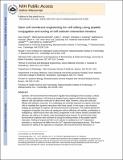| dc.contributor.author | Cheng, Hao | |
| dc.contributor.author | Byrska-Bishop, Marta | |
| dc.contributor.author | Zhang, Cathy T. | |
| dc.contributor.author | Kastrup, Christian | |
| dc.contributor.author | Hwang, Nathaniel S. | |
| dc.contributor.author | Tai, Albert K. | |
| dc.contributor.author | Lee, Won Woo | |
| dc.contributor.author | Xu, Xiaoyang | |
| dc.contributor.author | Nahrendorf, Matthias | |
| dc.contributor.author | Anderson, Daniel Griffith | |
| dc.contributor.author | Langer, Robert S | |
| dc.date.accessioned | 2015-10-23T14:44:52Z | |
| dc.date.available | 2015-10-23T14:44:52Z | |
| dc.date.issued | 2012-04 | |
| dc.date.submitted | 2012-02 | |
| dc.identifier.issn | 01429612 | |
| dc.identifier.issn | 1878-5905 | |
| dc.identifier.uri | http://hdl.handle.net/1721.1/99432 | |
| dc.description.abstract | Dynamic cell–microenvironment interactions regulate many biological events and play a critical role in tissue regeneration. Cell homing to targeted tissues requires well balanced interactions between cells and adhesion molecules on blood vessel walls. However, many stem cells lack affinity with adhesion molecules. It is challenging and clinically important to engineer these stem cells to modulate their dynamic interactions with blood vessels. In this study, a new chemical strategy was developed to engineer cell–microenvironment interactions. This method allowed the conjugation of peptides onto stem cell membranes without affecting cell viability, proliferation or multipotency. Mesenchymal stem cells (MSCs) engineered in this manner showed controlled firm adhesion and rolling on E-selectin under physiological shear stresses. For the first time, these biomechanical responses were achieved by tuning the binding kinetics of the peptide-selectin interaction. Rolling of engineered MSCs on E-selectin is mediated by a Ca[superscript 2+] independent interaction, a mechanism that differs from the Ca[superscript 2+] dependent physiological process. This further illustrates the ability of this approach to manipulate cell–microenvironment interactions, in particular for the application of delivering cells to targeted tissues. It also provides a new platform to engineer cells with multiple functionalities. | en_US |
| dc.description.sponsorship | National Heart, Lung, and Blood Institute (Programs of Excellence in Nanotechnology Award Contract HHSN268201000045C) | en_US |
| dc.description.sponsorship | National Institutes of Health (U.S.) (Grant 2-P30-CA14051) | en_US |
| dc.description.sponsorship | Armed Forces Institute of Regenerative Medicine (Award W81XWH-08-2-0034) | en_US |
| dc.language.iso | en_US | |
| dc.publisher | Elsevier | en_US |
| dc.relation.isversionof | http://dx.doi.org/10.1016/j.biomaterials.2012.03.065 | en_US |
| dc.rights | Creative Commons Attribution-Noncommercial-NoDerivatives | en_US |
| dc.rights.uri | http://creativecommons.org/licenses/by-nc-nd/4.0/ | en_US |
| dc.source | PMC | en_US |
| dc.title | Stem cell membrane engineering for cell rolling using peptide conjugation and tuning of cell–selectin interaction kinetics | en_US |
| dc.type | Article | en_US |
| dc.identifier.citation | Cheng, Hao, Marta Byrska-Bishop, Cathy T. Zhang, Christian J. Kastrup, Nathaniel S. Hwang, Albert K. Tai, Won Woo Lee, et al. “Stem Cell Membrane Engineering for Cell Rolling Using Peptide Conjugation and Tuning of Cell–selectin Interaction Kinetics.” Biomaterials 33, no. 20 (July 2012): 5004–5012. | en_US |
| dc.contributor.department | Harvard University--MIT Division of Health Sciences and Technology | en_US |
| dc.contributor.department | Massachusetts Institute of Technology. Department of Chemical Engineering | en_US |
| dc.contributor.department | Koch Institute for Integrative Cancer Research at MIT | en_US |
| dc.contributor.mitauthor | Cheng, Hao | en_US |
| dc.contributor.mitauthor | Byrska-Bishop, Marta | en_US |
| dc.contributor.mitauthor | Zhang, Cathy T. | en_US |
| dc.contributor.mitauthor | Xu, Xiaoyang | en_US |
| dc.contributor.mitauthor | Langer, Robert | en_US |
| dc.contributor.mitauthor | Anderson, Daniel Griffith | en_US |
| dc.relation.journal | Biomaterials | en_US |
| dc.eprint.version | Author's final manuscript | en_US |
| dc.type.uri | http://purl.org/eprint/type/JournalArticle | en_US |
| eprint.status | http://purl.org/eprint/status/PeerReviewed | en_US |
| dspace.orderedauthors | Cheng, Hao; Byrska-Bishop, Marta; Zhang, Cathy T.; Kastrup, Christian J.; Hwang, Nathaniel S.; Tai, Albert K.; Lee, Won Woo; Xu, Xiaoyang; Nahrendorf, Matthias; Langer, Robert; Anderson, Daniel G. | en_US |
| dc.identifier.orcid | https://orcid.org/0000-0002-1634-3329 | |
| dc.identifier.orcid | https://orcid.org/0000-0001-5629-4798 | |
| dc.identifier.orcid | https://orcid.org/0000-0003-4255-0492 | |
| mit.license | PUBLISHER_CC | en_US |
| mit.metadata.status | Complete | |
